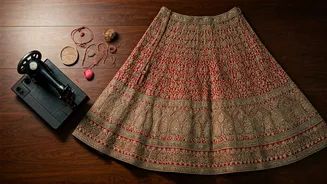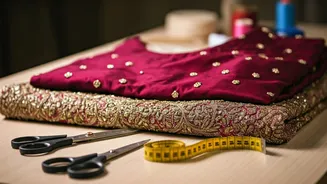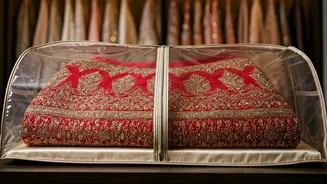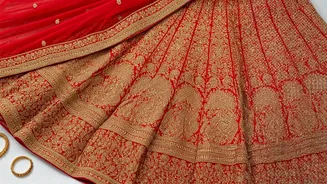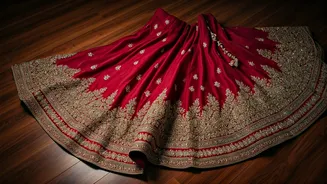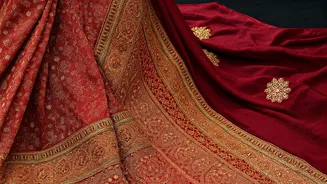Initial Preparation Steps
Before stowing your lehenga, a thorough cleaning and inspection are crucial. After the wedding festivities, take the lehenga to a reputable dry cleaner
experienced with delicate fabrics and embellishments. Ensure they are aware of any stains or embellishments like sequins or beadwork. Once cleaned, allow it to dry completely. Inspect the lehenga meticulously for any remaining stains, loose threads, or damage. Address any minor issues with careful mending or spot cleaning before proceeding. This initial preparation is the foundation for long-term preservation of your precious attire.
Selecting Storage Essentials
The right storage materials are essential to protect your lehenga. Use a breathable garment bag, preferably made from cotton or muslin, to shield the lehenga from dust, light, and moisture. Avoid plastic bags, as they can trap moisture and cause mildew. Acid-free tissue paper is a must-have for wrapping individual components of the lehenga, such as the skirt, blouse, and dupatta. This prevents snagging, discoloration, and maintains the fabric's shape. Invest in a sturdy, spacious storage box or trunk designed specifically for heirloom garments. Choose a container that will fit all pieces comfortably without overcrowding.
Packing Your Lehenga
Careful packing is vital for preserving the lehenga's intricate design. Lay the skirt flat and gently fold it, using acid-free tissue paper between the folds to prevent creases. Wrap the blouse and dupatta separately in tissue paper and place them carefully within the garment bag or storage box. For heavily embellished lehengas, consider wrapping individual embellishments with tissue paper to prevent them from catching on other fabrics. Ensure that the lehenga is not compressed or folded tightly. Overcrowding can lead to wrinkles and damage. Maintaining ample space prevents the weight from causing creases or damaging delicate embroidery.
Choosing the Right Location
The storage location greatly affects the lehenga's longevity. Select a cool, dry, and dark area in your home, away from direct sunlight, heat, and humidity. A closet in a guest room or a spare bedroom is often ideal. Avoid storing the lehenga in the attic, basement, or garage, as these areas tend to fluctuate in temperature and humidity. Regularly check the storage area for signs of pests, such as moths or silverfish, and take preventative measures if necessary. A well-ventilated space prevents moisture buildup, which can damage the fabric and cause mold.
Maintenance and Monitoring
Regular monitoring is crucial to ensure the lehenga remains in optimal condition. Inspect the lehenga at least twice a year, ideally before and after the monsoon season, for any signs of damage, such as discoloration, mold, or pest activity. Carefully remove the lehenga from its storage, unfold it gently, and examine all parts, paying close attention to embellishments and seams. If any issues are detected, address them immediately with professional cleaning or mending. Refold the lehenga using fresh tissue paper and repack it in the garment bag or storage box. Routine maintenance ensures that minor issues are addressed before they become significant problems.
Addressing Stains & Repairs
Should you discover stains or damage on your lehenga, prompt action is essential. Do not attempt to treat stains yourself, as this can potentially worsen the problem. Seek professional dry cleaning services immediately, ensuring they specialize in delicate fabrics and intricate embroidery. If minor repairs are needed, such as loose threads or beadwork, take the lehenga to a skilled tailor or seamstress experienced with bridal wear. For significant damage, consult a specialist who can provide restoration services. Addressing issues quickly helps prevent further deterioration and preserves the lehenga's value and beauty.
Preventing Pest Infestation
Protecting your lehenga from pests, such as moths and silverfish, requires preventative measures. Use natural pest repellents, such as cedar blocks or lavender sachets, placed within the storage container. These natural alternatives are less harmful to delicate fabrics than chemical-based products. Regularly inspect the storage area for any signs of pest activity, such as droppings or damaged fabric. If pests are detected, remove the lehenga immediately and have it professionally treated. Thoroughly clean and vacuum the storage area to eliminate any pest eggs or larvae. Combining preventative strategies with routine inspections helps to safeguard your lehenga from damage.


